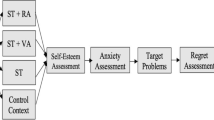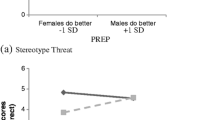Abstract
In this study, we examined how math identity moderates women's response to gender-related stereotypes in the domain of mathematics. Male and female college students with varying degrees of math identification took a challenging math test with a gender-related stereotype either activated (i.e., stereotype threat) or nullified. Consistent with previous research, women performed worse than men in the stereotype threat condition, but equal to men in the stereotype nullification condition when performance was adjusted for math SAT scores. Moreover, when faced with stereotype threat, high math-identified women discounted the validity of the test more than did less math-identified women or men in general. We discuss potential benefits and drawbacks of a discounting strategy for women who are highly identified with math.
Similar content being viewed by others
References
Ambady, N., Shih, M., Kim, A., & Pittinsky, L. T. (2001). Stereotype susceptibility in children: Effects of identity activation on quantitative performance. Psychological Science, 12, 385–389.
American Association of University Women. (1995). How schools shortchange girls: The AAUW Report. New York: Marlowe.
Arkin, R. M., & Oleson, K. C. (1998). Self-handicapping. In J. M. Darley & J. Cooper (Eds.), Attribution and social interaction: The legacy of Edward E. Jones (pp. 313–347). Washington, DC: American Psychological Association.
Benbow, C. P., Lubinski, D., Shea, D. L., & Eftekhari-Sanjani, H. (2000). Sex differences in mathematical reasoning ability at age 13: Their status 20 years later. Psychological Science, 11, 474–480.
Benbow, C. P., & Stanley, J. C. (1980). Sex differences in mathematical ability: Fact or artifact? Science, 210, 1262–1264.
Brown, R. P., & Josephs, R. A. (1999). A burden of proof: Stereotype threat and gender differences in math performance. Journal of Personality and Social Psychology, 76, 246–257.
Coley, R. J. (2001). Differences in the gender gap: Comparisons across racial/ethnic groups in education and work. Retrieved March 29, 2005, from http://www.ets.org/research
Covington, M. (1992). Making the grade: A self-worth perspective on motivation and school reform. Cambridge, UK: Cambridge University Press.
Crocker, J., & Major, B. (1989). Social stigma and self esteem: The self-protective properties of stigma. Psychological Review, 96, 608–630.
Crocker, J., Voelkl, K., Testa, M., & Major, B. (1991). Social stigma: The affective consequences of attributional ambiguity. Journal of Personality and Social Psychology, 60, 218–228.
Devine, P. G. (1989). Stereotypes and prejudice: Their automatic and controlled components. Journal of Personality and Social Psychology, 56, 5–18.
Eccles, J. S., Barber, B., Jozefowicz, D., Malenchuk, O., & Vida, M. (1999). Self-evaluations of competence, task values, and self-esteem. In N. Johnson, M. Roberts, & J. Worell (Eds.), Beyond appearance: A new look at adolescent girls (pp. 53–83). Washington, DC: American Psychological Association.
Eccles, J. S., Jacobs, J. E., & Harold, R. E. (1990). Gender role stereotypes, expectancy effects, and parents' socialization of gender differences. Journal of Social Issues, 46, 183–201.
Educational Testing Service. (2002). Sex, race, ethnicity, and performance on the GRE General Test. Retrieved December 1, 2003, from http://www.gre.org/codelist.html
Fennema, E., & Sherman, J. (1977). Sex-related differences in mathematics achievement, spatial visualization, and affective factors. American Education Journal, 14, 51–71.
Ford, T. E., Ferguson, M. A., Brooks, J. L., & Hagadone, K. M. (2004). Coping sense of humor reduces effects of stereotype threat on women's math performance. Personality and Social Psychology Bulletin, 30, 643–653.
Gonzalez, P., Guzman, J. C., Partelow, L., Pahlke, E., Jocelyn, L., Kastberg, D., et al. (2004). Highlights from the Trends in International Mathematics and Science Study (TIMSS) 2003 (NCES 2005–005). [U.S. Department of Education, National Center for Educational Statistics.] Washington, DC: U.S. Government Printing Office.
Gonzalez, P. M., Blanton, H., & Williams, K. J. (2002). The effects of stereotype threat and double-minority status on the test performance of Latino women. Personality and Social Psychology Bulletin, 28, 659–670.
Harris, A. M., & Carlton, S. T. (1993). Patterns of gender differences on mathematics items on the Scholastic Aptitude Test. Applied Measurement in Education, 6, 137–151.
Heatherton, T. F., & Polivy, J. (1991). Development and validation of a scale for measuring state self-esteem. Journal of Personality and Social Psychology, 60, 895–910.
Inzlicht, M., & Ben Zeev, T. (2000). A threatening intellectual environment: Why females are susceptible to experiencing problem-solving deficits in the presence of males. Psychological Science, 11, 365–371.
Johns, M., Schmader, T., & Martens, A. (2005). Knowing is half the battle: Teaching stereotype threat as a means of improving women's math performance. Psychological Science, 16, 175–179.
Keller, J. (2002). Blatant stereotype threat and women's math performance: Self-handicapping as a strategic means to cope with obtrusive negative performance expectations. Sex Roles, 47, 193–198.
Keller, J., & Dauenheimer, D. (2003). Stereotype threat in the classroom: Dejection mediates the disrupting effect on women's math performance. Personality and Social Psychology Bulletin, 29, 371–381.
Kobrynowicz, D., & Branscombe, N. R. (1997). Who considers themselves victims of discrimination? Individual difference predictors of perceived gender discrimination in women and men. Psychology of Women Quarterly, 21, 347–363.
Leary, M. R., & Shepperd, J. A. (1986). Behavioral self-handicaps versus self-reported handicaps: A conceptual note. Journal of Personality and Social Psychology, 51, 989–997.
Leyens, J. P., Desert, M., Croizet, J. C., & Darcis, C. (2000). Stereotype threat: Are lower status and history of stigmatization preconditions of stereotype threat? Personality and Social Psychology Bulletin, 26, 1189–1199.
Major, B., Spencer, S., Schmader, T., Wolfe, C., & Crocker, J. (1998). Coping with negative stereotypes about intellectual performance: The role of psychological disengagement. Personality and Social Psychology Bulletin, 24, 34–50.
McKown, C., & Weinstein, R. S. (2003). The development and consequences of stereotype consciousness in middle childhood. Child Development, 74, 498–515.
Meece, J. L., Parsons, J. E., Kaczala, C. M., Goff, S. B., & Futterman, R. (1982). Sex differences in math achievement: Toward a model of academic choice. Psychological Bulletin, 91, 324–348.
O'Brien, L. T., & Crandall, C. S. (2003). Stereotype threat and arousal: Effects on women's math performance. Personality and Social Psychology Bulletin, 29, 782–789.
Osborne, J. W. (1995). Academics, self-esteem, and race: A look at the underlying assumptions of the disidentification hypothesis. Personality and Social Psychology Bulletin, 21, 449–455.
Osborne, J. W. (1997). Race and academic disidentification. Journal of Educational Psychology, 89, 728–735.
Osborne, J. W. (1999, April). Historical trends in academic disidentification by race: 1972–1992. Paper presented at the meeting of the American Education Research Association, Montreal, Canada.
Pronin, E., Steele, C. M., & Ross, L. (2004). Identity bifurcation in response to stereotype threat: Women and mathematics. Journal of Experimental Social Psychology, 40, 152–168.
Quinn, D. M., & Spencer, S. J. (2001). The interference of stereotype threat with women's generation of mathematical problem-solving strategies. Journal of Social Issues, 57, 55–71.
Rosenberg, M. (1965). Society and the adolescent self-image. New Jersey: Princeton University Press.
Sackett, P. R., Hardison, C. M., & Cullen, M. J. (2004). On interpreting stereotype threat as accounting for African American-White differences on cognitive tests. American Psychologist, 59, 7–13.
Schmader, T. (2002). Gender identification moderates stereotype threat effects on women's math performance. Journal of Experimental Social Psychology, 38, 194–201.
Schmader, T., & Johns, M. (2003). Converging evidence that stereotype threat reduces working memory capacity. Journal of Personality and Social Psychology, 85, 440–452.
Schmader, T., Johns, M., & Barquissau, M. (2004). The costs of accepting gender differences: The role of stereotype endorsement in women's experience in the math domain. Sex Roles, 50, 835–850.
Schmader, T., Major, B., & Gramzow, R. H. (2001). Coping with ethnic stereotypes in the academic domain: Perceived injustice and psychological disengagement. Journal of Social Issues, 57, 93–111.
Smith, J. L. (2004). Understanding the process of stereotype threat: A review of mediational variables and new performance goal directions. Educational Psychology Review, 16, 177–206.
Smith, J. L., & White, P. H. (2001). Development of the Domain Identification Measure: A tool for investigating stereotype threat effects. Educational and Psychological Measurement, 61, 1040–1057.
Smith, J. L., & White, P. H. (2002). An examination of implicitly activated, explicitly activated, and nullified stereotypes on mathematical performance: It's not just a woman's issue. Sex Roles, 47, 179–191.
Spencer, S. J., Steele, C. M., & Quinn, D. M. (1999). Stereotype threat and women's math performance. Journal of Experimental Social Psychology, 35, 4–28.
Steele, C. M. (1997). A threat in the air: How stereotypes shape intellectual identity and performance. American Psychologist, 52, 613–629.
Steele, C. M., & Aronson, J. (1995). Stereotype threat and the intellectual test performance of African Americans. Journal of Personality and Social Psychology, 69, 797–811.
Steele, J., James, J. B., & Barnett, R. C. (2002). Learning in a man's world: Examining the perceptions of undergraduate women in male-dominated academic areas. Psychology of Women Quarterly, 26, 46–51.
Stone, J. (2002). Battling doubt by avoiding practice: The effects of stereotype threat on self-handicapping in White athletes. Personality and Social Psychology Bulletin, 28, 1667–1678.
Stone, J., Lynch, C. I., Sjomeling, M., & Darley, J. M. (1999). Stereotype threat effects on Black and White athletic performance. Journal of Personality and Social Psychology, 77, 1213–1227.
Swim, J. K. (1994). Perceived versus meta-analytic effect sizes: An assessment of the accuracy of gender stereotypes. Journal of Personality and Social Psychology, 66, 21–36.
Tesser, A., & Campbell, J. (1980). Self-definition: The impact of the relative performance and similarity of others. Social Psychology Quarterly, 43, 341–346.
van Laar, C. (2000). The paradox of low academic achievement but high self-esteem in African American students: An attributional account. Educational Psychology Review, 12, 33–61.
Wheeler, S. C., & Petty, R. E. (2001). The effects of stereotype activation on behavior: A review of possible mechanisms. Psychological Bulletin, 127, 797–843.
Wilder, G. Z., & Powell, K. (1989). Sex differences in test performance: A survey of literature (College Board Report No. 89-3; ETS RR No. 89-4). New York: College Entrance Examination Board.
Yzerbyt, V. Y., Muller, D., & Judd, C. M. (2004). Adjusting researchers' approach to adjustment: On the use of covariates when testing interactions. Journal of Experimental Social Psychology, 40, 424–431.
Author information
Authors and Affiliations
Corresponding author
Rights and permissions
About this article
Cite this article
Lesko, A.C., Corpus, J.H. Discounting the Difficult: How High Math-Identified Women Respond to Stereotype Threat. Sex Roles 54, 113–125 (2006). https://doi.org/10.1007/s11199-005-8873-2
Issue Date:
DOI: https://doi.org/10.1007/s11199-005-8873-2




